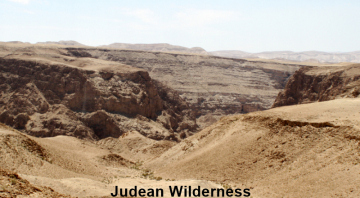During the time of the New Testament church, the wilderness of Judea was known as a place where thieves and robbers resided. The Apostle Paul was initially thought by the Romans, after he was arrested at the temple, to be an Egyptian man who led many murderers to the area (Acts 21:37 - 38).
How big was it?
The area considered Judea, under the Roman Empire, included the areas (or parts thereof) of the ancient Israelite tribes of Benjamin, Simeon, Judah, Ephraim and Dan. It included the cities of Bethany, Bethlehem, Emmaus, Ephraim, Hebron, Jericho, and Jerusalem. What is commonly referred to as Judea's wilderness is located on the far eastern side of the province, near the Jordan River and the Dead Sea. Under the Romans, this area was ruled by Herod the Great from 37 to 4 B.C. It was then governed by one of his sons, Herod Archelaus, from 4 B.C. to 6 A.D.
A wilderness, like the one in Judea, is commonly thought to be a place absent of trees and completely destitute of inhabitants. In the New Testament, however, the original Greek word (Eremos, Strong's Concordance #G2048) means a rough and mountainous area that is sparsely settled that does have some forests.

This type of land is best used as pasture rather than for tilling. It was in such the rough terrain of the wilderness that John the Baptist preached repentance to the masses (Matthew 3).
Why does it exist?
The reason why there is a wilderness area near the Jordan is due to an effect called the 'rain shadow.' As weather travels eastward over this part of the world, it encounters the hills of Judea lying east of Jerusalem. As warm, moist air from the Mediterranean rises toward the top of the hills, it condenses and drops its moisture just before crossing over the hill tops. The now dryer air continues its journey eastward toward the river.
This dry strip of land that runs alongside the Jordan River and the Dead Sea receives roughly a quarter of the total amount of rainfall that places like eastern Jerusalem are blessed to receive. Such a small amount of rain would, naturally, produce a wilderness area.
New Testament importance
The most well-known reference to the wilderness of Judea is in regard to Jesus' temptation by Satan the devil. The book of Luke records how, for a period of 40 days and 40 nights, Satan tempted Jesus to sin. References to Jesus' temptation are also in Matthew 4 and Mark 1.
Luke records three specific temptations brought by the devil in the wilderness. The first temptation was to eat food while Jesus was fasting (Luke 4:3). The second was to be given immediate power over the world (verses 5 - 7). The third was to test God's love for him (verse 9). Although Luke only lists three times the devil tried to deceive Jesus, other Scriptures indicate that Christ was tempted to sin the entire time he fasted (Mark 1:13, Luke 4:2).